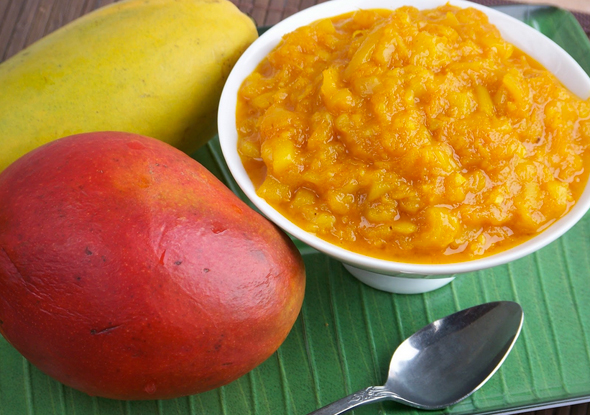Mama’s Punjabi Recipes: Mithhe Ambh di Chatni (Sweet Mango Chutney)
If there’s one fruit that wins the heart of Indians, it has to be the mango which is grown all over. The mango is the national fruit of India, Pakistan and The Philippines and the national tree of Bangladesh. And any schoolkid in these countries can proudly tell you, it takes seven years before a mango tree can produce any fruit; the Alphonso variety is best for eating but the smaller ones can be sucked through the skin and you make tasty pickles and amchoor from the small, pungent, green ones.
And the mango is even celebrated in the fashion and design world, being drawn in a shape commonly known as paisley but named ambhi in Punjabi. It is a symbol that sprang up millennia ago somewhere between present-day Iran and Kashmir.
Chutneys are popular condiments – mistakenly referred to as sauce in the West – to dip finger foods in, or even to spice up a parantha or yogurt dish. Chutneys are usually made of herbs and spices for seasoning, which are ground together with some vinegar, lemon or tamarind juice to add the tanginess. Spices most commonly used include methi (fenugreek), dhania(coriander), jeera (cumin) and hing (asafoetida).
There are many varieties of chutneys and their ways of preparation vary across the Indian Sub-Continent. Major Grey’s Chutney is an Anglicized variety which is sweet and spicy with raisins, mango, vinegar, lime juice, onion and tamarind popular in the UK and the US and was reputedly created by a 19th-century British Army officer who served in Colonial India.
This recipe for mithhe ambh di chutney (sweet mango chutney) is quite quick and simple to make and can be eaten like a spicy preserve on toast and certainly with your favorite snack or dish.
Ingredients:
2 large ambh (mangoes) – any type, ripe ones
100 gm gur (brown rock cane sugar, jaggery)
1 tsp sirka (white vinegar)
Spices: 2 tsp mirch (red pepper), 1 tsp garam masala, 1 tsp methi dana (fenugreek seed) powder
Directions:
1.Wash the mangoes and then peel them.
2.Take the pulp off and place it into a bowl. Throw away the seed and puree the pulp with a fork.
3.Crush the gur into small pieces and then add it into the pulp. Now add the red pepper, garam masala and methi dana powder and mix well. Do not add salt to this chutney.
4.Pour into a jar and mix in the vinegar. Keep in the fridge for long preservation.
5.Serve with bread, roti or any snack.
MAMA’S TIP OF THE WEEK
WHEN GROWING KARELAS, WATCH OUT FOR THE SHELL SNAILS
Many Indians have a small patch of garden where they grow vegetables, either out of a fondness for gardening or just to get some items that they can’t easily get in the supermarkets. One of these is the karela (bitter gourd) which has its own beneficial uses and is also very easy to grow as a vine that creeps up the back fence or a lattice on the side wall. The leaves exude a wonderful pungent, burnt smell when they are rustled and the fruit starts off with a small yellow flower.
Unfortunately, shell snails also like the aroma of the karela and will destroy the vine by creeping up and leaving a trail on the leaves that just turns them brown and crispy. The best way to get rid of them is by sprinkling a snail and slug killer pellets around the base of the vines, but you still have to pick off the pests from the leaves as you see them.

Shakuntla Malhotra is a skilled cook of Punjabi dishes made in the old-fashioned style that she learnt as a young woman in her ancestral home in Lyallpur (since renamed Faisalabad), India before it became part of Pakistan after the Partition in 1947. People have often admired her cooking for its simplicity and taste that comes with each mouthful. Even in her mid-eighties, she continues to cook daily and agreed to share some of her delectable Punjabi recipes.

